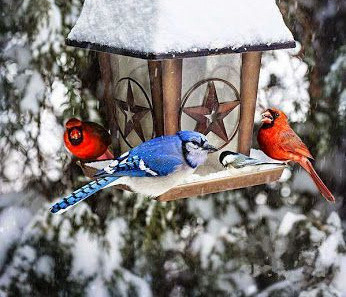
Do your own research too: What seeds work best in your yard to attract the birds you enjoy most?
|
The kinds of seeds you offer at your feeders will dictate what birds are attracted. Knowing this, experienced birders focus their seed feeding on the specific birds they want to attract. Beginners often think the more variety the better, but some seeds can lead to problems with certain birds (and squirrels) that you may not appreciate. With that in mind, some birders don’t provide seeds that attract birds they don’t want to visit their feeders. The understanding of the give and take of attracting the birds you prefer with the food they prefer, and withholding seeds that attract unwanted visitors all begins with reading the ingredient lists on seed packages, especially mixed seed blends.
Experienced birders concentrate on feeding a few kinds of seeds – primarily black oil sunflower seeds, nyjer thistle seeds, and peanuts. Black oil sunflower seeds provide the highest level of food value for most birds, followed by striped sunflower seeds. Shelled sunflower seeds are a best case option, because they don’t leave the mess that accumulates from discarded sunflower shells. Sunflower seed chips are similar, but are cut or “chipped” to make them smaller for smaller birds.
Smaller finches will eat shelled and chipped sunflower seeds, but many people prefer to offer nyjer thistle seeds, which are similar to small seeds goldfinches and juncos glean in area fields. Thistle seeds are said to have the most oil content of any seeds, in spite of their small size.
Preferred by some larger birds, peanuts are sure to attract jays, cardinals, woodpeckers, nuthatches, and others.
In the Mix
The best seed mixes have a combination of the above seeds (but minus the thistle), and maybe some ‘secondary seeds’ listed below, but many advanced birders avoid secondary seeds altogether. Overall, it’s a good idea to read the ingredient lists on the seed packages, inspect the seed mix through the see-through packaging, and make sure you’re getting what you’re paying for – and what the birds you wish to attract prefer. Some lesser seeds are often over-emphasized in seed mixes, especially mixes you tend to buy at grocery stores. Opt to do your shopping at a wild bird store if you can, although if that’s not an option, some hardware stores and specialty stores offer quality bird seeds and seed mixes.
Shelled seed mixes devoid of secondary bird seeds have gained popularity and are considered preferred by many birders due to the lack of shell mess. Ultimately, you pay only for seeds and not for shells and secondary filler seeds. You can make your own seed mixes too; a popular option is to mix some shelled peanuts with a greater volume of shelled sunflower seeds. The bottom line is that you should feed the seeds preferred by the birds you want to attract and observe.
An excellent resource to learn about what seeds many common feeder visitors prefer at high, moderate, and low levels can be referenced at FoodPreferences (ectownusa.net)
Primary Bird Seeds – black oil sunflower seeds, sunflower chips, striped sunflower seeds, nyjer thistle seeds, peanuts.
Secondary Bird Seeds – safflower seeds.
Avoid These Seeds – millet, red milo, and cracked corn.
Seed Mixes – shelled seed mixes, preferred seed mixes (“grocery store mixes” not recommended).
Of course, it’s also important to offer a balanced food mix that includes suet and fresh water too. And in the Sunbelt, wintering hummingbirds and some other birds will utilize sugar-water nectar; plus if there are orioles in your neighborhood, orange halves and grape jelly are also an option.
Do your own research too: What seeds work best in your yard to attract the birds you enjoy most?
Enjoy the birds around you, and share your backyard birding experiences and photos with The Birding Wire anytime at editorstbw2@gmail.com